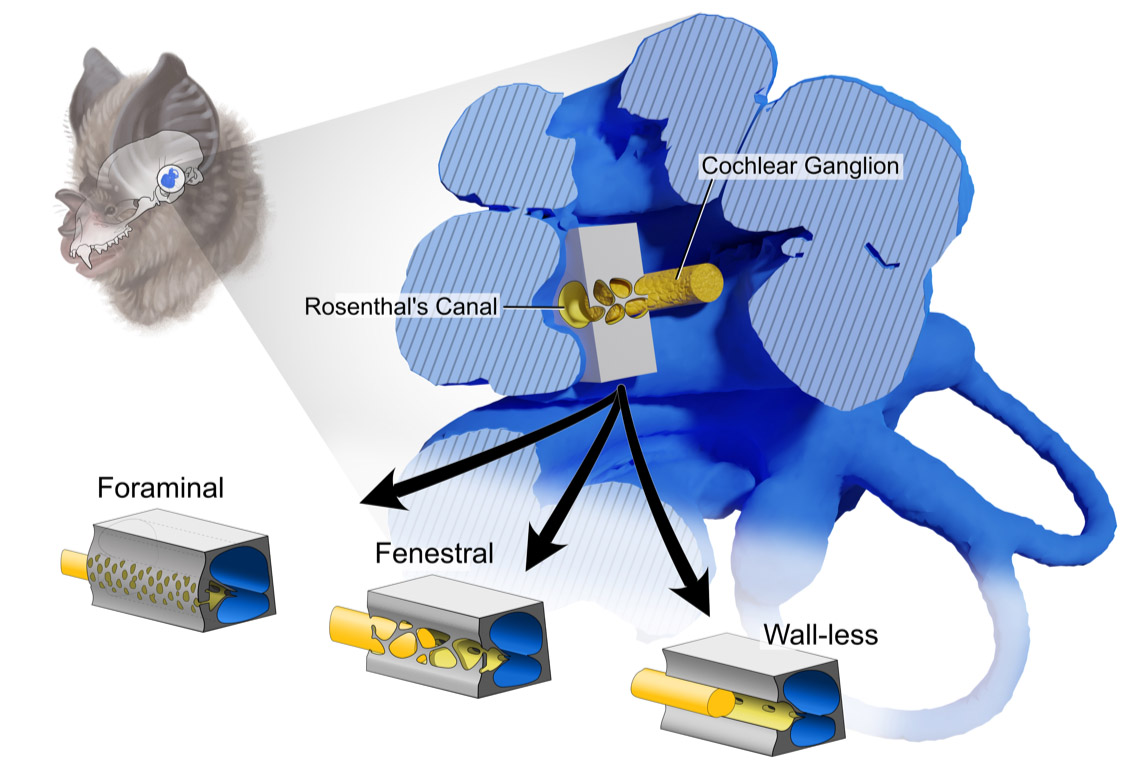Bats are famous for using echolocation—a process where emitted sound waves bounce off objects, providing information about their size, distance, and the surrounding environment. Bats have a unique inner ear structure that helps them hear these echoes. In a new study, researchers have discovered that this structure varies greatly among bats, providing new insights into the evolution of echolocation.

The inner ear of bats consists of a snail-shaped tube, known as the cochlea, that is lined with sensory hair cells and is filled with fluid. When the sound waves enter the tube, the fluid vibrates, resulting in a cascade of events. The hair cells convert the vibration into neural signals, which are passed onto the ganglion neurons that transmit the signals to the brain. These neurons are surrounded by a bony tube, called Rosenthal’s canal, which is the focus of the new study.
“Bats have inner ears that are more specialized compared to all other mammals, and I thought that their better hearing, especially for high-pitch sounds, might be related to differences in their ganglion neurons,” said Zhe-Xi Luo, a professor of organismal biology and anatomy at the University of Chicago. “When we looked, we discovered that several bats don’t have the canal that is ubiquitous in most other mammals.”
The researchers used computed tomography and histological studies to examine the skulls of 38 bat species that belonged to either Yinpterochiroptera or Yangochiroptera. Yin bats rely on constant frequency sounds for echolocation, while Yang bats use a more complex, modulated frequency. To the researchers’ surprise, they found that the Yang bats, which includes most bats, did not have a typical canal for their neurons. Instead, the canal is open on one side and has a larger space so their neurons are free to vary. According to the researchers, Yin bats have up to 17,000 neurons in this region, whereas Yang bats have up to 45,000-46,000.
“Every mammal has had some form of Rosenthal’s canal that is covered in bone, except the Yang group of bats,” said Benjamin Sulser, the lead author of the paper and a graduate student at the American Museum of Natural History. “It is possible that bats have managed to evolve with different types of permutations to this structure, which corresponds to so many different species of bats with different ecological specializations.”
The study also provides evidence for resolving the long-standing controversy surrounding the evolutionary classification of bats. Traditionally, bats where divided into two groups: Megachiroptera, or megabats, which feed on fruit and use sight and smell, and Microchiroptera, or microbats, which mostly feed on insects and use echolocation. However, genetic evidence uncovered in the 2000s suggested that the some of the echolocating bats were more closely related to megabats than to other echolocating bats. As a result, two new groups of bats, Yin and Yang, were proposed. Researchers hypothesized that echolocation either evolved separately in these groups or evolved in bat ancestors and was later lost in some of the Yin bats.
“The DNA evidence completely changed our understanding of bat classification,” said Daniel Urban, a senior outreach activities coordinator at the IGB and an author on the paper. “However, there was no actual anatomical characteristic that supported this DNA hypothesis, until now. And this study shows the differences in the ganglion canal are consistent with the split between Yin and Yang bats.”
The researchers are interested in continuing their studies on the evolution of bat echolocation by comparing the anatomy involved in hearing echoed sounds among bats and other mammals. “There is this idea that scientists know almost everything. The canal is a key structure that we didn’t know could vary, and by investigating it we have uncovered something new,” Sulser said.
“Bats are fascinating model organisms because we don’t know some of these fundamental things about their origins,” Urban said. “If you look at the fossil records, the oldest known bat is 52 million years old and it looks like a modern bat. It probably also had echolocation, and trying to figure out whether it evolved from a single event that got lost in one lineage or if there were two different origins of echolocation is an important question.”
The study “Evolution of inner ear neuroanatomy of bats and implications for echolocation” was published in Nature and can be found at https://doi.org/10.1038/s41586-021-04335-z. The work was funded by the University of Chicago, the National Science Foundation, the Field Museum, the JRS Biodiversity Foundation, and the University of Illinois Urbana-Champaign.
